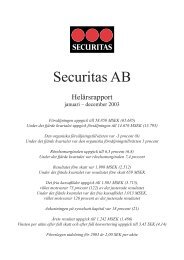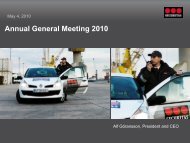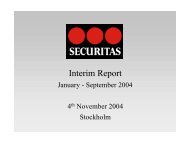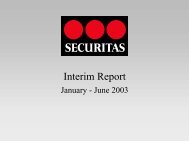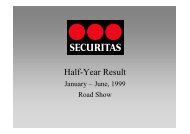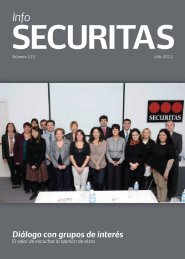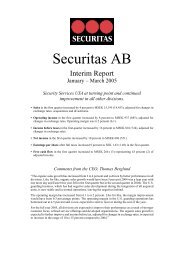Securitas AB Annual Report 2005
Securitas AB Annual Report 2005
Securitas AB Annual Report 2005
Create successful ePaper yourself
Turn your PDF publications into a flip-book with our unique Google optimized e-Paper software.
net assets, and qualify for the hedge accounting criteria, exchange rate differences<br />
on such loans are recognized together with the exchange rate differences arising<br />
from the translation of foreign net assets in the translation reserve in equity.<br />
Intra-group transactions (IAS 24 and IFRS 3)<br />
Pricing of deliveries among Group companies is determined using normal business<br />
principles. Intra-group receivables and liabilities, transactions between Group<br />
companies and the resulting internal income have been eliminated.<br />
Revenue recognition (IAS 11 and IAS 18)<br />
The Group’s revenue is generated from various types of security services and the<br />
sale of alarm products. Revenue from security services is recognized in the period<br />
in which it is earned. Alarm installations are recognized in revenue as they are<br />
completed, in accordance with the percentage of completion method. According to<br />
this method, revenue, expenses, and thus, income are recognized in the period in<br />
which the work was undertaken. The determination of the percentage of alarm installations<br />
that can be recognized as revenue is based on the time spent in relation<br />
to the total estimated time. Interest income and borrowing costs are recognized in<br />
the statement of income in the period to which they are attributable.<br />
Segment <strong>Report</strong>ing (IAS 14)<br />
The Group’s operations are divided into fi ve divisions that provide the operational<br />
structure for internal controls, follow-ups and reporting. For both internal and<br />
external reporting, each division represent a primary segment. The split of Security<br />
Services into Security Services USA and Security Services Europe refl ects both<br />
the internal operational structure as well as the differences between the risks and<br />
rates of return within the two segments. The secondary segments consists of the<br />
three main geographical areas in which the Group is active: Nordic region, Europe<br />
excluding Nordic Region and USA. In addition to this the operations outside these<br />
regions are included in Rest of world. The geographical split represents various<br />
levels of market development in terms of wages, employee turnover, product mix,<br />
market growth and profi tability. The total sales for the geographical split are<br />
given by the location of the sales. The location of the sales in all material aspects<br />
corresponds to the location of the customers.<br />
IAS 14 stipulates that costs in any particular segment (division) should not<br />
include general administrative expenses, expenses for head offi ces and other central<br />
expenses. These expenses are accounted under the heading Other. Moreover, the<br />
segment’s assets and liabilities include only those items that have been utilized/<br />
arisen in ongoing operations. Other balance sheet items, primarily current tax,<br />
deferred tax, and provisions for taxes, are accounted for separately under the<br />
Other heading.<br />
Accounting for Government Grants<br />
and Disclosure of Government Assistance (IAS 20)<br />
<strong>Securitas</strong> as well as other employers are eligible to a number of grants having to do<br />
with employees. Grants relate to training, incentive for hiring new staff, reduction<br />
of working hours, etc. All grants are accounted for in the statement of income as a<br />
cost reduction in the same period as the related underlying cost.<br />
Taxes (IAS 12)<br />
Provisions are made for all taxes that are expected to be levied on income for the<br />
year, including deferred tax. Deferred tax is calculated in accordance with the<br />
liability method. Deferred tax is based on net changes in temporary differences<br />
between the book value and taxable value of assets and liabilities. The calculation<br />
of deferred tax liabilities and deferred tax claims is recognized in the same way as<br />
the underlying transactions were recognized as of the balance sheet date and refers<br />
to all taxable temporary differences, provided they do not pertain to goodwill<br />
or shares in subsidiares. Anticipated tax rates are applied in the years when the<br />
temporary differences are likely to be reversed.<br />
A deferred tax asset is recognized when it is probable that suffi cient taxable<br />
income will arise that the deferred tax asset can be offset against. Deferred tax assets<br />
are valued as of the balance sheet date, and any potential previously unvalued<br />
deferred tax asset is recognized when it is expected to be usable, or correspondingly,<br />
reduced when it is expected to be wholly or partly unusable against future taxable<br />
income.<br />
Current and deferred taxes are posted directly to shareholders’ equity if the relevant<br />
underlying transaction or event is posted directly to shareholders’ equity in<br />
the period, or previous period if it pertains to an adjustment of an opening balance<br />
of retained earnings as the result of a change in accounting principle, or if it relates<br />
to exchange rate differences in the translation of the balance sheets of foreign subsidiaries<br />
that are posted to shareholders’ equity.<br />
Provisions are allocated for estimated taxes on dividends from subsidiaries to<br />
the parent company in the following year.<br />
Statement of cash fl ow (IAS 7)<br />
The statement of cash fl ow has been prepared in accordance with the indirect<br />
method. Liquid assets include Cash and bank deposits and Short-term investments<br />
with a maximum duration of 90 days at the time of initial recognition.<br />
Notes and comments to the consolidated fi nancial statements<br />
Foreign currency receivables and liabilities (IAS 21)<br />
When preparing the fi nancial statements of individual companies, foreign currencydenominated<br />
receivables and liabilities are translated using the exchange rates<br />
prevailing at each balance sheet date.<br />
Goodwill and other acquisition related<br />
intangible fi xed assets (IFRS 3, IAS 36 and IAS 38)<br />
In accordance with the provisions of IFRS 3:<br />
■ The Group ceased amortisation of goodwill from January 1, 2004.<br />
■ Accumulated amortization as at December 31, 2004 has been eliminated with<br />
a corresponding decrease in the cost of goodwill.<br />
■ From the year ended December 31, 2004 onwards, goodwill is tested annually<br />
for impairment, as well as when there are indications of impairment.<br />
The Group has reassessed the useful lives of its intangible assets in accordance<br />
with the provisions of IAS 38. No adjustment resulted from this reassessment.<br />
Goodwill represents the excess of the cost of an acquisition over the fair value<br />
of the Group’s share of the identifi able net assets of the acquired subsidiary/operations<br />
at the date of acquisition. Goodwill is tested annually for impairment and<br />
carried at cost less accumulated impairment losses. Gains and losses on the disposal<br />
of an entity include the carrying amount of goodwill relating to the entity sold.<br />
Other acquisition related intangible fi xed assets arising from acquisitions can<br />
include different types of intangible fi xed assets such as marketing-related, customer-related,<br />
contract-related and technology-based. Other acquisition related<br />
intangible fi xed assets normally have a defi nite useful life. These assets are recognized<br />
at fair value on the date of acquisition and subsequently carried at cost less<br />
accumulated amortization and any accumulated impairment losses. Amortization is<br />
calculated using the linear method to allocate the cost of assets over their estimated<br />
useful lives. <strong>Securitas</strong>’ acquisition related intangible fi xed assets mainly relate to<br />
customer contract portfolios and the related customer relationships. The valuation<br />
of the customer contract portfolios and the related customer relationships is<br />
based on the Multiple Excess Earnings Method (MEEM) which is a valuation<br />
model based on discounted cash fl ows. The valuation is based on the churn rates<br />
and profi tability of the acquired portfolio at the time of the acquisition. In the<br />
model a specifi c charge, contributory asset charge, is applied as a cost or return<br />
requirement for the assets supporting the intangible asset. Cash fl ows are discounted<br />
on an after tax basis using the Weighted Average Cost of Capital (WACC) adjusted<br />
for local interest rate levels in the countries of acquisition. The useful life of<br />
customer contract portfolios and the related customer relationships are based on<br />
the churn rate of the acquired portfolio and are normally within the range of 3 to<br />
20 years corresponding to a yearly amortization of 5 percent to 33.3 percent.<br />
A deferred tax liability is calculated at the local tax rate on the difference between<br />
the book value and tax value of the intangible asset. The deferred tax liability<br />
is amortized over the same period as the intangible asset, which means that it<br />
neutralizes the impact of the amortization of the intangible asset on the full tax<br />
rate percentage on the income after tax. The initial recognition of this deferred<br />
tax liability increases the amount of goodwill.<br />
Goodwill and other acquisition related intangible fi xed assets are allocated to<br />
cash-generating units (CGU) on a level which is consistent with the level that<br />
<strong>Securitas</strong> monitors performance that is per country in a division (segment). This<br />
allocation is also the basis for the yearly impairment testing.<br />
The amortization of acquisition related intangible fi xed assets is shown on the<br />
line Amortization of acquisition related intangible fi xed assets in the statement of<br />
income.<br />
Acquisition related restructuring costs<br />
Acquisition related restructuring costs are costs that are either recognized on a<br />
cash basis that is in the period when the corresponding payment is made or costs<br />
that are recognized as provisions for restructuring in accordance with IAS 37. The<br />
costs that have been recognized in the statement of income for 2004 and <strong>2005</strong> are<br />
all costs recognized on a cash basis and thus no provisions are recognized.<br />
Other intangible fi xed assets (IAS 36 and IAS 38)<br />
Other intangible fi xed assets are recognized if it is probable that the expected<br />
future economic benefi ts that are attributable to the asset will fl ow to the Group<br />
and that the cost of the asset can be measured reliably. Other intangible fi xed<br />
assets normally have a defi nite useful life. These assets are recognized at cost and<br />
subsequently carried at cost less accumulated amortization and any accumulated<br />
impairment losses.<br />
Linear depreciation is used for all asset classes, as follows:<br />
Software licenses 12.5–33.3 percent<br />
Other intangible fi xed assets 20–33.3 percent<br />
Rental rights and similar rights are amortized over the same period as the<br />
underlying contractual period.<br />
SECURITAS <strong>2005</strong> 81




